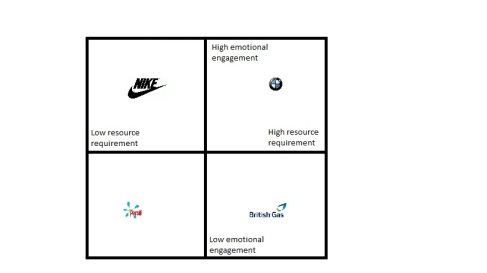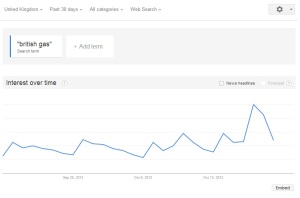Lots of people think that British Gas made a mistake by running an online Q&A session on the day they announced a big price hike. And they did attract some cynicism. But is that a bad thing?
The Drum has a measured analysis of the events, and concludes that it was a brave attempt at engagement that reflected their brand values.
But would it have been better to do nothing? The Drum says this would have been “the easy old-school option”. Well, the old ways are sometimes the best and there is an expression that might just sum up the situation: “Let sleeping dogs lie”.
One of the ways to look at social media strategy is to map a brand on a grid with one axis representing a consumer’s emotional engagement with the brand and the other representing the amount of resources (time or money) required from the consumer.
In the grid below:
- the high emotional engagement/low resource requirement is represented by Nike
- the low emotional engagement/low resource requirement is represented by Persil
- the high emotional engagement/high resource requirement is represented by BMW
- the low emotional engagement/high resource requirement is represented by British Gas
So far, all very consultancy. But what use is this grid? Well, I think it can at least hint at appropriate social media strategies.
Persil (low engagement, low resource requirement) has the easiest task – they simply need to watch out for storms: listen to the online buzz to make sure they are not about to be presented with a crisis. And every brand needs to do this.
But Persil will be hard pressed to create any additional brand engagement through social media: most people don’t want to talk about washing powder!
Nike has an opportunity to create brand engagement as people are often passionate about the clothing brands they wear. Social media used well can be a very effective (and cost effective) branding tool for them. And it can be used to stimulate sales for instance with “friend gets friend ” or “gift a friend” schemes, as Starbucks has done recently. But using social media for CRM or to generate sales directly (i.e. on a one-to one basis) is unlikely to be an effective strategy. Their products just are not expensive enough to justify that.
BMW upon the other hand can create brand engagement (people love their cars) and also use it for CRM, defusing unhappy customers and responding to questions. They can potentially even drive sales to individuals or groups of individuals as the cost of doing this is justified by the profit on sale. For them social media is a massive opportunity.
And finally British Gas. They are perhaps in an unenviable position. Like all brands they need to monitor online buzz. But there is little opportunity for them to enhance their brand because people are simply uninterested in utilities and will generally only talk about them if they have a complaint.
But because people spend a lot of money on their gas and electricity, they will need to respond to individual complaints carefully as aggrieved individuals who feel they have lost a lot of money may well be more persistent about bad-mouthing the brand. On the upside, this is an opportunity to reduce churn.
So, was the British Gas Q&A session a mistake? It seems to me that they placed themselves in the wrong quadrant of my grid – they tried to use social media to promote brand engagement when, as a low emotion brand (and one that people potentially resent), that was always unlikely to be successful.
It may not have done much good, but it probably didn’t matter much either. Yes, searches for “British Gas” on Google doubled (see the chart from Google Trends below) but the peak only lasted a couple of days. Most people won’t have noticed or cared.
The real cost to British Gas was perhaps in management time and stress!

